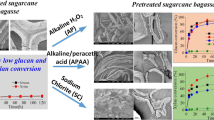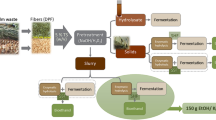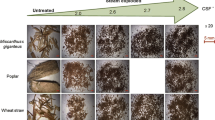Abstract
Chemical and surface characteristics of sulfite-pretreated royal palm sheath (RPS) fibers and parenchyma cells were investigated in order to study cell-type-dependent biomass hydrolysis by cellulase. Size, chemical composition, cellulose crystallinity and the exposure of cellulose microfibrils in pretreated RPS biomass affected the enzymatic accessibility and digestibility of different cell-type substrates.



Similar content being viewed by others
References
Chunilall V, Bush T and Erasmus RM (2012) Investigating the lignocellulosic composition during delignification using confocal raman spectroscopy, crosspolarization magic angle spinning carbon 13-nuclear magnetic resonance (CP/MAS 13C-NMR) spectroscopy and atomic force microscopy. Cellulose Chem Technol 46: 269–267
Daud WRW, Law KN (2011) Oil palm fibers as papermaking material: potentials and challenges. Bioresources 6:901–917
Jørgensen H, Kristensen JB, Felby C (2007) Enzymatic conversion of lignocellulose into fermentable sugars: challenges and opportunities. Biofuel Bioprod Bior 1:119–134
Khiari R, Mhenni MF, Belgacem MN, Mauret E (2010) Chemical composition and pulping of date palm rachis and Posidonia oceanica—a comparison with other wood and non-wood fibre sources. Bioresource Technol 101:775–780
Koljonen K, Österberg M, Kleen M, Fuhrmann A, Stenius P (2004) Precipitation of lignin and extractives on kraft pulp: effect on surface chemistry, surface morphology and paper strength. Cellulose 11:209–224
Rao KMM, Rao KM (2007) Extraction and tensile properties of natural fibers: vakka, date and bamboo. Compos Struct 77:288–295
Saritha M, Arora A, Nain L (2012) Pretreatment of paddy straw with Trametes hisuta for improved enzymatic saccharification. Bioresource Technol 104:459–465
Segal L, Creely JJ, Martin AE (1959) An empirical method for estimating the degree of crystallinity of native cellulose using the X-Ray diffractometer. Text Res J 29:786–794
Shuai L, Yang Q, Zhu JY (2010) Comparative study of SPORL and dilute-acid pretreatments of spruce for cellulosic ethanol production. Bioresource Technol 101:3106–3114
Sun Y, Cheng JY (2002) Hydrolysis of lignocellulosic materials for ethanol production: a review. Bioresour Technol 83:1–11
Zeng MJ, Ximenes E, Ladisch MR, Mosier NS, Vermerris W, Huang CP, Sherman DM (2011) Tissue-specific biomass recalcitrance in corn stover pretreated with liquid hot-water: enzymatic hydrolysis (Part 1). Biotechnol Bioeng 109:390–397
Zhu JY, Pan XJ (2010) Woody biomass for cellulosic ethanol production: technology and energy consumption evaluation. Bioresour Technol 101:4992–5002
Zhu L, O’Dwyer JP, Chang VS, Granda CB, Holtzappled MT (2010) Multiple linear regression model for predicting biomass digestibility from structural features. Bioresource Technol 101:4971–4979
Acknowledgments
We thank the support of Fundamental Research Funds for the Central Universities (No. 2012ZB0020) and National Natural Science Foundation of China (No. 31170549).
Author information
Authors and Affiliations
Corresponding author
Electronic supplementary material
Below is the link to the electronic supplementary material.
10529_2012_1079_MOESM1_ESM.tif
Supplementary Figure 1: AFM phase images of alkali sulfite RPS fibers (a), alkali sulfite RPS fines (b), delignified alkali sulfite fibers (c)and delignified alkali sulfite fines (d), recorded at a scan rate of 1 Hz and a scan size of 2 × 2 μm2 (TIFF 4137 kb)
10529_2012_1079_MOESM2_ESM.tif
Supplementary Figure 2: X-ray diffraction patterns and the crystallinity indices of RPS biomass.Note: Biomass crystallinity index (CI) was calculated from the height ratio between the intensity of the crystalline peak(I002 − Iam) and total intensity (I002) (1959). I002 refers to the peak intensity for the crystalline portion of biomass at about2θ = 22.5° and Iam represents the intensity for the amorphous portion at about 18°. Cellulose crystallinity index (CrIc)11 was predicted using O’Dwyer’s empirical equation, CrIc = 1.097 (CrIb) + 0.939 (Xylan content) − 11.433 (TIFF 577 kb)
Rights and permissions
About this article
Cite this article
Li, N., Liu, H., Fu, S. et al. Cell-type-dependent enzymatic hydrolysis of palm residues: chemical and surface characterization of fibers and parenchyma cells. Biotechnol Lett 35, 213–218 (2013). https://doi.org/10.1007/s10529-012-1079-0
Received:
Accepted:
Published:
Issue Date:
DOI: https://doi.org/10.1007/s10529-012-1079-0




